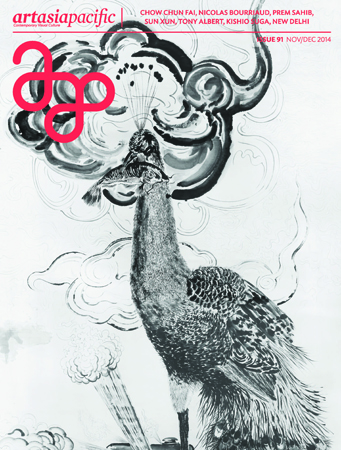ArtAsiaPacific
November/December 2014
Out now
In the November/December issue of ArtAsiaPacific, we look at post-1980s artists who are attempting to comprehend the rapid transformations taking place today—from a micro-level of specificity, such as the situation of Hong Kong, to larger world-views of the human relationship to nature and history.
Our Features begin with an in-depth look at Chow Chun Fai and his career as a painter, photographer and activist in Hong Kong. Guest contributor Stephanie Bailey traces the trajectory of Chow’s paintings based on stills from Hong Kong cinema of the 1970s and ’80s, as well as later films that followed, which explore the complicated identity of the Special Administrative Region’s citizens, particularly in the lead-up to the 1997 British handover of the city back to China.
Taipei desk editor David Frazier connects with influential French curator and critic Nicolas Bourriaud—recognized for his “relational aesthetics”—just days before his first Asian biennial opened at the Taipei Fine Arts Museum in September. Bourriaud discusses his approach to the 2014 Taipei Biennial, envisioned as a platform to reflect on the importance of social relationships, particularly in a world of hyperindustrialization, capitalism and ecological change.
From India, scholar Shanay Jhaveri sits down with recent Royal Academy of Arts, London, graduate Prem Sahib on the eve of his first solo exhibition in Mumbai to discuss the sense of intimacy and community evoked in his minimalist installations, often inspired by nightclubs and changing rooms.
Finally, Beijing-based independent curator Tiffany Beres discusses the art of Sun Xun, whose work appears on the cover of this issue. Sun, one of China’s fastest-rising post-’80s generation stars, is known for his cryptic animated films, often inspired by authors such as George Orwell and Yevgeny Zamyatin and their political satires on futuristic, dystopian societies. Yet, it is Sun’s use of the traditional Chinese ink that lends a quality of timelessness to his dreamlike films. Reflecting on his new work, What Happened in the Year of the Dragon (2014), Beres writes, “The ultimate result of Sun’s animation then, is not so much a film, as we have come to recognize it, but rather a manuscript—an alluringly immersive visual work of authorship.”
Capping off Features is our special column Inside the Burger Collection, where we introduce artist Nadia Kaabi-Linke and sociologist Timo Kaabi-Linke’s Digging for Redemption, a forensic-intervention-cum-artist-project that delves into the history of the AM Qattan Foundation’s Mosaic Rooms gallery in London.
In Profiles, editor-at-large HG Masters looks at the career of Gu Wenda, whose works incorporate human hair and placenta powder; and from Sydney, contributing editor Michael Young talks with artist Tony Albert, the winner of two back-to-back art prizes in Australia. From London, West and Central Asia editor Sara Raza interviews Saudi collector and philanthropist Basma al-Sulaiman.
Turning to Essays, Dubai desk editor Kevin Jones contemplates the way the Louvre Abu Dhabi is crafting its own unique narrative in the United Arab Emirates. For Case Study, Chin-Chin Yap explores copyright issues around the emerging field of artificial creativity, and from Myanmar we analyze the loosening of censorship laws under the present military junta government.
For Where I Work, managing editor John Jervis headed to Japan’s Izu peninsula to visit the studio of Mono-ha artist Kishio Suga. Dispatch takes us to New Delhi, where contributing editor Jyoti Dhar explains how the longevity of its dynamic art scene depends on beefing up long-term support for experimental initiatives such as Khoj International Artists’ Association. For The Point, Kevin Mitchell, interim provost of the American University of Sharjah, argues that educational institutions should value transformative learning experiences over test scores and ranking systems. In One on One, Lee Wen, best known for his “Yellow Man” series, relates his admiration for younger performance artist Jason Lim. Whether close up or panoramic, instantaneous or long-term, many of the artists in this issue illustrate how art that emerges from conflict can turn discord into forms of understanding.
Select articles now online in Arabic and Chinese: www.artasiapacific.com
Subscribe to the print edition, buy digital copies on iTunes, Zinio or Magzter, and follow us on Facebook, Twitter and Instagram.
